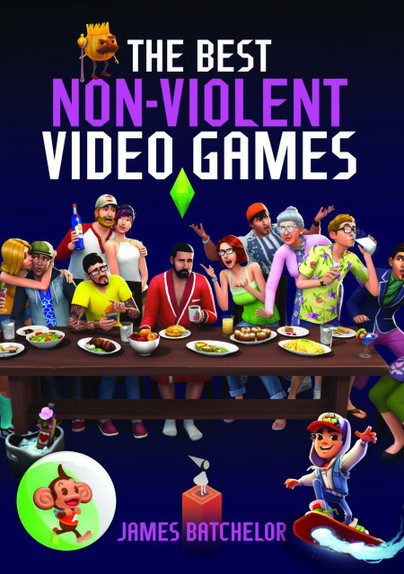
In his new book, The Best Non-Violent Video Games, James Batchelor celebrates 300 games from the past 50 years. It’s a pleasing collection, including hits from down the years, such as Pong, Animal Crossing, Journey, and Candy Crush Saga.
Notably, more than 160 of the games listed were released in the last ten years, while around 50 came out pre-2000 (many of which are sports simulations). Batchelor says this is partly down to a wish to include games that are easy for readers to obtain and play, but also due to the growth in games that do not feature violence, often made by independent studios.
Batchelor is a journalist (he is the editor-in-chief of Gamesindustry.biz) who also runs a blog and Twitter account called Non-Violent Game of the Day. Thus far, he has collected the names of more than 5,000 non-violent games.
GameDaily spoke to him about his book, and about the status of non-violent games.
GameDaily: Why are there more non-violent games coming out these days, than in the past?
Batchelor: “Non-violent games have certainly become more prevalent and more prominent. That’s worked hand-in-hand with the rise of the indie scene. I would estimate that more than three quarters of the games in the book are from indies, who are more willing to take risks than big studios. They are trying to stand out by catering to different audiences and to people who want something that’s not the usual triple A fare.”
GameDaily: We sometimes hear of developers who become disillusioned with working on violent games …
Batchelor: “I’ve definitely spoken to developers over the last few years who’ve worked at triple A studios, on the constant cycle of annual, two or three year releases that are nothing but shooting and hacking and slashing – these very graphic, combat driven games. They have decided that, no, I want to play something different and I want to make something my kids can enjoy. I want to make something that appeals to different people, that’s more personal and relatable to a broader audience of people.
“I think there’s a fatigue within some elements of the development scene, where people are tired of making the same stuff over and over again, and want to try something different.
“You notice the problem at big gaming showcases where the vast majority of games are violent, or a huge proportion of them come from a violent sub-genre like gory space shooters. The whole center of it is, you get to kill stuff, and it can feel a bit overwhelming. These moments when gaming shows the world what it’s producing – and it’s mostly about killing things – misrepresents what videogames are about, and what they can do.”
GameDaily: It all goes back to the deep roots of gaming – to the days of arcades when it was easier to make games about shooting things that might only last a few minutes.
Batchelor: ” A developer I once told me that the moment this started was the release of Space Invaders. People realized that using one pixel to fire at another pixel making it disappear created an endorphin boost, the psychological satisfaction you get from making an obstacle or an enemy just disappear, and that loop is still successful today.
“John Romero (Doom co-creator) says in the book’s introduction that it’s easy to design a violent game because controlling a thing that destroys everything else on the screen is a really easy interaction that the player never has to relearn. If you play any triple A game, you’re likely to know exactly what you have to do.
“But there’s also a general recognition that games are about action and control. They are about verbs – doing things – and we need more verbs. It’s hard to find new verbs, so we should celebrate when developers go to the effort of trying new things, and succeeding.”
GameDaily: Game companies traditionally trying to define their audience as primarily young men hasn’t helped …
Batchelor: “The fact is that more than half the global gaming audience is female. We tend to think of games in terms of consoles and PC, but mobile is the biggest platform of all, where games like Candy Crush are hugely popular. The success of Farmville on Facebook showed how many people want to play games about nurturing and sharing, and the mobile space in particular has really built on that over the years.
“But at some point, games companies decided that our core audience was males ages 16 to 34. Games were included in the boys’ section of Toys R Us rather than the girls’ section. It was circular. The companies decided boys were more likely to buy the things they were making and so they continued making them and selling them to boys, and now some companies are entirely reliant on franchises about killing things.”
GameDaily: So we come back to how it’s the indies who are willing and able to take risks, by making games that are also great stories that engage our emotions and our empathy.
Batchelor: “I absolutely love the use of storytelling in video games, which can tell stories like no other medium, because you are an active participant in the story. I especially love games where you discover the story in a nonlinear fashion, such that it’s almost impossible for anyone to have the exact same progression through that story.
“Once you step away from the violence and the combat as a core loop, and you focus on the story, there’s so many interesting ways to deliver entertainment. I want to see more developers doing that.”
Colin Campbell has been reporting on the gaming industry for more than three decades, including for Polygon, IGN, The Guardian, Next Generation, and The Economist.
 GameDaily.biz © 2025 | All Rights Reserved.
GameDaily.biz © 2025 | All Rights Reserved.